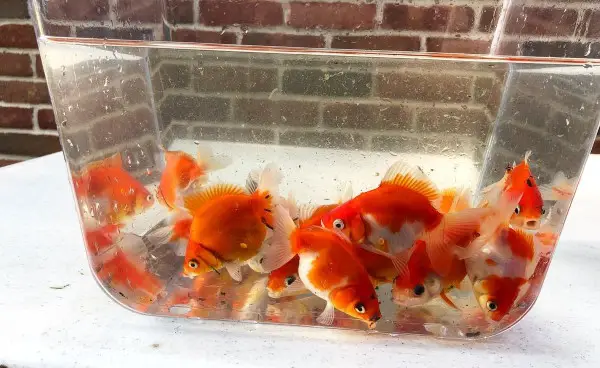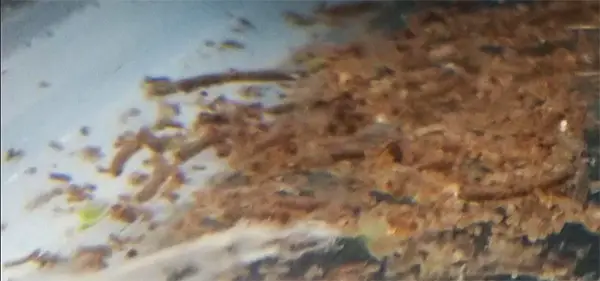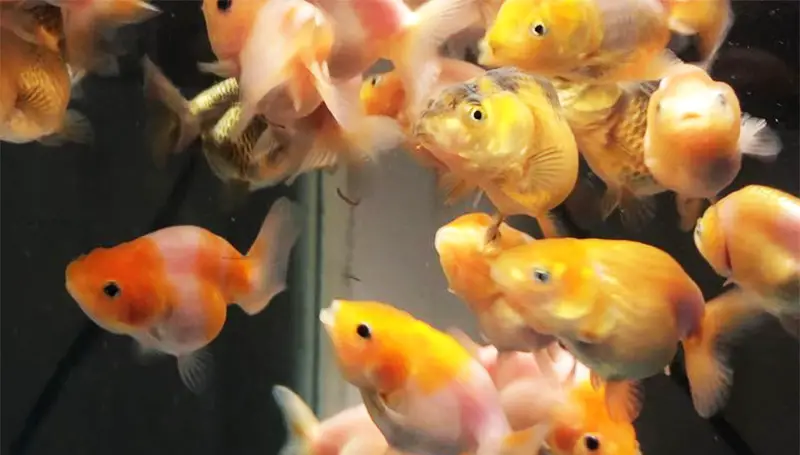Lots of people will tell you lots of rules about how many fish can be kept in what size of an aquarium. But, the truth is that there is no simple answer to that question. This is because there are variables involved that can’t be simplified to X fish per Y gallons. There are no hard and fast rules when it comes to how many fish you can keep in your aquarium (no matter the size).
Read this article in full if you want to know how many fish you can really keep in your aquarium. And find out exactly how to tell if you have too many fish!
What Limits How Many Fish We Can Keep?
The main thing that limits how many fish you can keep in any size aquarium is water chemistry. Specifically, what the concentration of ammonia, nitrite, and nitrate is.

Ammonia builds up in your aquarium as your fish eat, breathe, and poop. Luckily, beneficial bacteria lives in our aquariums and, most importantly, on our filter media. This beneficial bacteria processes the ammonia into nitrite, and then ultimately, nitrate.
Ammonia and nitrite are pretty bad for our fish. Ideally, you want those numbers to be as close to zero as possible. Whereas, nitrate is less damaging to our fish and—depending on who you ask—can build up to around 40 parts per million before you need to do a water change to dilute its concentration.
More Water Changes = More Fish
So, logic follows that you can put more fish in your aquarium if you do more regular water changes in order to dilute the nitrate more often.
Have you ever seen an absolutely packed aquarium on YouTube? Inevitably, somebody will be telling the uploader off in the comments—”tank is overstocked!”
The truth is that the commenter has no idea if the tank is overstocked because they don’t know the aquarium owner’s water change schedule. Perhaps they do daily water changes, and maybe those water changes are huge! 90%! It’s impossible to know whether a tank is overstocked by looking at it.
Filtration & Aquarium Stocking Levels
Your filter must be home to a healthy colony of beneficial bacteria in order for you to have any fish in it. Let alone a lot of fish. This is for the reasons mentioned above; i.e. the bacteria must be present in order to process the dangerous ammonia into nitrite, and finally, into nitrate.

The quantity and quality of your filter media comes into play. Ideally, your filter media should have a high surface area so as to give the beneficial bacteria lots of places to live!
If you don’t have enough filtration (both media and flow rate) then it’s possible your filter won’t be able to keep up with the ammonia. If your bacteria colony cannot process the ammonia and nitrite fast enough then you will soon start to see your fish suffering.
Oxygen Levels
Oxygen levels are another chemical concern when it comes to your home aquarium.
Three main factors play into how well-oxygenated your aquarium water is.
First and most importantly is surface agitation. Think of nature, ponds are often still and stagnant. As such, they struggle to maintain a lot of fish. Because the water is motionless it doesn’t have a lot of interaction with the air and therefore it doesn’t absorb a lot of oxygen. Again, thinking of nature, imagine a fast flowing mountain stream. In such a stream, the water is well oxygenated because there is so much agitation on the surface of the water.

Temperature is the next thing that affects how much oxygen your water holds. Warmer water holds less oxygen. So, bearing in mind what temperature range the species of fish you keep are comfortable at, you could (technically) keep the water at a lower temperature to raise oxygen levels. However, I find that if you have enough surface agitation that you shouldn’t have to worry about oxygen levels in your aquarium.
Surface area is the third and final factory. The larger your aquarium’s surface, the more opportunity for gaseous exchange your aquarium has.
While oxygen levels should always be a consideration, they usually aren’t a concern. If your fish are deprived of oxygen you will soon find out because they will gulp at the surface.
Territory, Interaction & Comfort
Admittedly, most fish don’t seem to be too smart. This is especially true of fish like cyprinids (goldfish, danios, minnows, et al) and characins (tetras, silver dollars, piranha). So, I find that they don’t mind being packed in together, as long as the water quality is good! In fact, as schooling fish, they actually enjoy the company of their own kind a great deal—it puts them at ease.
However, not all fish are dim! For example, cichlids are very intelligent and, to make it worse, they are quite territorial. So, even if the water quality is good, you might find that they are stressed if kept together in too small of a quarters.
Fish Poop!
I said in the last section that fish like goldfish didn’t mind being packed in together. And, in terms of social interaction, that’s true. However, some fish, goldfish especially, are very messy fish.
They are messy in both the way they eat and the amount of waste they produce.

Excess waste left in the aquarium contributes to ammonia production and should be siphoned out of the aquarium regularly. This should be part of your water change regime; i.e. buy a nice gravel vac and make sure to get as much of the grime and poop out of the substrate as possible.
Keeping a clean aquarium will allow you to keep more fish in your aquarium.
Fish Grow!
Speaking of goldfish, they grow pretty big (up to 12 inches). And that’s true of a lot of fish sold at pet stores. So, keep that in mind any fish you buy you will need to research to find its ultimate size.
Buy A Test Kit!
It’s easy to appreciate why newcomers want to hear simple rules like X inches of fish per Y gallons. And it’s also easy to understand why experienced fishkeepers tell newcomers simple rules. It’s probably because it’s easier to tell people something straightforward than it is to outline the dynamic chemical workings of a home aquarium.

However, it doesn’t have to be a challenge. Luckily we have accurate test kits that tell us exactly what the water chemistry of our fish tank water is. Just buy a test kit (affiliate link) and test your water every now and then to make sure you have virtually no ammonia, virtually no nitrite, and a reasonable amount of nitrate.
Get A Feel For It
As you become a more experienced fishkeeper, you’ll start to “get a feel” for how your aquariums are doing. Because if your fish look happy and healthy, then the water parameters are probably fine!
A Bigger Tank Is Always Better
It can be tempting as a newcomer to the hobby to buy a ten gallon tank to see how it goes. But, by doing so you are making things much more difficult for yourself. A larger body of water is less prone to sudden swings in water chemistry because there is more water to buffer a spike in ammonia, nitrite, and/or nitrate.
Yes, it’s true that you can offset overstocking concerns with adequate filtration, and most importantly, more water changes. However, the truth is that a bigger tank is always better.
Be Realistic With Yourself
This is a really important message: be realistic with yourself. Sure, you can stock your aquarium heavily feeling like you will do the water changes to compensate. But, the truth is that life can intervene and you might struggle to keep up with lots of water changes.
Plants! A Fishkeeper’s Best Friend!
This is the final tip for stocking your aquarium: include some real, live aquarium plants. This is because as they grow they will consume the damaging nitrogen compounds your fish produce. Having healthy, growing plants in your aquarium allows you to keep more fish.

However, keep in mind that you will need to match your aquarium plants to your fish. For example, goldfish will most aquatic plants. So, in their case, you should get something like anubias or java fern. This is because fish that like plants (goldfish, silver dollars, et al) won’t eat anubias or java fern because they find the leaves unpleasant.
Conclusion
People like rules because it’s very comfortable to know them and follow them. So, you’ll encounter a lot of people in the hobby telling you the stocking rules for aquariums. However, I implore you to keep an open mind and remember to focus on the actual chemistry of your water. Ammonia, nitrite, and nitrate will tell you if your fish tank is overstocked. Not somebody in the YouTube comment section.


